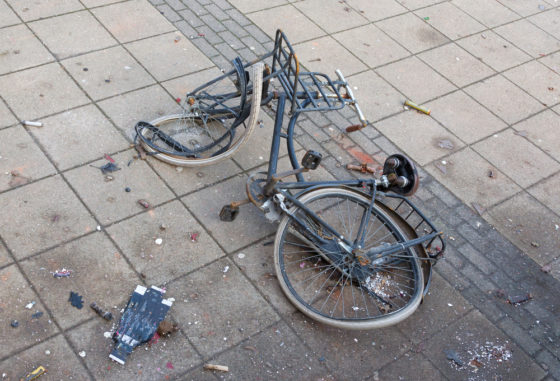Cycling injuries ‘three times more than official figures’


Three times more cyclists are seriously wounded in traffic accidents than the official figures record, reports Trouw.
For some years, experts have questioned whether published statistics reflect all serious incidents, because they are only based on police reports rather than also including accident and emergency and ambulance data.
According to Trouw, two provincial governments have asked the safety organisation VeiligheidNL to recalculate figures also including hospital and ambulance treatment after traffic accidents.
In Friesland, the number of cyclist accidents rose eightfold with the new counting method, and VeiligheidNL estimates that statistics nationwide would more than triple.
Insights
Cycling experts believe that it is extremely important to know how many accidents there really are and their locations and causes, in order to improve road safety. ‘We have known for years that the statistics are patchy, but it is very important to know where accidents are happening,’ said Martijn van Es of cyclists’ organisation the Fietsersbond.
‘Utrecht and Friesland are the first regions to do this, and Limburg will follow, but we hope that other provinces will do the same.’
Sipke van der Meulen, secretary of the regional traffic and transport board in Friesland, agreed, telling Trouw: ‘It is important to know that eight times more cyclists are injured because provincial and local road managers base their policy on police figures. The correct data about the causes and locations for cyclist accidents can give us better insights in order to take action.’
‘80,000 injuries’
While national infrastructure ministry figures report 14,000 seriously wounded cyclists in 2019, the most recently recorded year, VeiligheidNL estimates that there were actually some 80,000 injuries of which 50,000 were serious. The organisation reportedly came to its estimate on the basis of 14 accident and emergency wards’ figures.
Next year the ministry intends to record ambulance data too, but there are currently no plans to include hospital treatment for accident-related problems such as broken bones that do not require overnight treatment.
Last year, according to the CBS, the highest number of cyclists ever died in traffic accidents, with 229 fatal incidents. A third of these involved e-bikes, and there has recently been discussion about whether users of these should wear a helmet.
Helmet
‘This is not just about helmets, but all kinds of means,’ said van Es. ‘If a large proportion of e-bike accidents involved hip or shoulder injury, then is compulsory helmet wearing the most logical thing to do to make it safer? The new figures could be very different, and we don’t have a full picture right now.’
Cycling levels in the Netherlands are the highest in the world, with more than a quarter of all journeys taking place and up to half of travel within cities.
Although fatalities are very low per km cycled, in an international context, more minor cycling crashes have long been underreported, according to the International Transport Forum. In 2018, the Netherlands Institute for Transport Policy Analysis, acknowledged that serious injuries ‘appear to be rising’.
A report from the Dutch road safety foundation in 2019 said that consistent helmet wearing would reduce serious head injury by 60% and fatal injuries by around a third.
DutchNews.nl has contacted VeiligheidNL for comment.
Thank you for donating to DutchNews.nl.
We could not provide the Dutch News service, and keep it free of charge, without the generous support of our readers. Your donations allow us to report on issues you tell us matter, and provide you with a summary of the most important Dutch news each day.
Make a donation